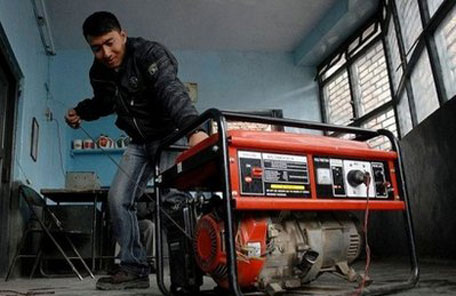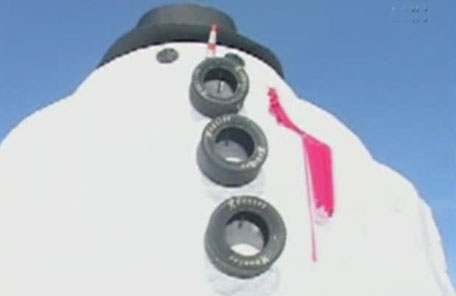- City Fajr Shuruq Duhr Asr Magrib Isha
- Dubai 04:20 05:42 12:28 15:53 19:08 20:30
Kiwi PM in “hot” water over Liz
 (REUTERS)
(REUTERS)
The Prime Minister of New Zealand has come under fire for describing Liz Hurley as "hot", according to The Sun.
John Key, 49, was asked on a sports radio show if he would like to be Australian cricket star Shane Warne.
He replied: "Yeah, well, given his current liaisons with Liz Hurley. I reckon she's hot." Key went on to name the model as a "definite" dream date.
But women's rights campaigner Sue Kedgeley branded the married dad of two's remarks as "boorish" - adding: "They seem more like 1960s.”
Stalker nicked Queen’s knickers
A writer has uncovered the amazing story of the first celebrity stalker - a lad of 14 who repeatedly broke into Buckingham Palace and stole Queen Victoria's bloomers.
The Sun reports that Edward Jones sat on the throne, slept in one of the Palace beds, sneaked into the young Victoria's apartments, read her letters and even hid beneath her sofa.
Jones broke in three times between 1838 and 1841 and on each occasion got within yards of the newly-crowned monarch before he was caught.
Once, he was nabbed trying to get out of the Queen's dressing room window with a pair of her knickers tucked into his trousers.
The story of the stalker, who was known to the police as the Boy Jones, has been pieced together from old newspaper reports by lecturer Dr Jan Bondeson.
Lights out for TV news in Nepal
 (AFP)
(AFP)
Nepal's most watched television station is to broadcast its main evening news bulletin in semi-darkness from Tuesday to highlight the problems caused by the country's chronic electricity shortage.
Kantipur Television said it would rely on traditional kerosene lanterns - a common sight across Nepal - to light the studio every night in a symbolic protest over the power crisis.
It hopes to pressurise the government to resolve an electricity shortage that sees homes and businesses in Nepal plunged into darkness for up to 18 hours a day, despite the huge potential for hydropower in the Himalayan nation.
The programme, broadcast every evening, is to be renamed after the Nepalese word for lantern and will carry themed news reports, starting with an interview Tuesday with Nepal's energy minister.
"It is a symbolic protest, but we hope it will strike a chord with our viewers," Kantipur's news chief Tirtha Koirala told AFP.
"These power cuts have brought people's daily lives to a standstill. Media organisations are losing money because no one can watch the television in a power cut and we are forced to use expensive generators to broadcast.
"There are no penalties on the government for failing to provide these basic needs, so we wanted to put moral pressure on them to do something."
Impoverished Nepal relies mainly on hydropower for its electricity, but produces only 634 megawatts a year, well short of the national requirement, according to the Nepal Electricity Authority.
Experts say the Nepal's huge mountain river system could be generating up to 83,000 megawatts of power, allowing it to sell surplus electricity to other countries.
But political instability and the lack of security have prevented the necessary investment.
Big Frosty: man builds 35-ft. snowman
 (AP)
(AP)
A northern New York man has topped his own record by building a 35-foot, top hat-wearing snowman on his property.
Vern Scoville started building huge snowmen several years ago as something fun for his family and friends to do after the holidays. Last year, his snowman topped out at 25 feet.
This year, Frosty stands 35 feet high just off Route 126 in the Jefferson County town of Champion, 70 miles north of Syracuse.
The snowman sports three black car tires for buttons, an orange and white traffic cone for a nose and part of an old pool for a top hat.
The mammoth snowman is a local attraction, especially for children who like to get their pictures taken standing in front of it.
Prisoners train dog to detect diabetes
A cute little dog is in jail Down Under - learning how to sniff out diabetes in people.
Pascoe, a 12-month-old Cavalier King Charles Spaniel, is being taught the medical marvel by inmates at Junee Prison in southern New South Wales - training to pick up changes in people's body odor or their breath so he can be a diabetic alert dog.
As soon as Pascoe learns to follow his nose - with sweet, fruity smells warning of high blood sugar levels or rusty, acidic smells indicating low blood sugar - he will be given to a family with a diabetic child to alert them to changes in glucose levels.
"The prisoners take it very seriously," Junee Prison's manager Andy Walker said of the Pups in Prison training program. "It does boost morale."
Meanwhile, in a separate report Tuesday, scientists in Japan have backed a theory that dogs can use their sense of smell to detect cancer in people.
The study by a team at Fukuoka Dental College Hospital was reported in the British Medical Journal.
Team leader Dr. Hideto Sonoda, cited by Australian Associated Press, said the work confirmed a "specific cancer scent does indeed exist and that cancer-specific chemical compounds may be circulating throughout the body."
In the dating game, speaking styles count
 (REUTERS)
(REUTERS)
American researchers have found a new way to predict the success of a relationship - compare the speaking style of a couple.
In a study of college students they found that couples whose language was in sync were almost four times more likely to want to see each other again than those who did not use similar language.
"We are able to predict this at higher rates than the people themselves," said Professor James Pennebaker, of the University of Texas, who headed the research team.
The researchers, who reported their findings in the journal Psychological Science, focused on function words - which are not nouns or verbs but the words that show how those words relate. For example: a, be, anything, that, will, him.
"Function words are highly social and they require social skills to use," Pennebaker explained. "For example, if I'm talking about the article that's coming out, and in a few minutes I make some reference to 'the article', you and I both know what that article means."
As part of the experiment, about 40 pairs of college students participated in four-minute speed dates and had their conversations recorded.
"We found that function words are a powerful reflection of somebody's psychological state," Pennebaker said. "You can tell when people are in the same state or are on the same page."
A second part of the study examined the everyday instant message conversations between already dating couples over a 10-day period. The conversations were analyzed by a computer for words and conversational patterns.
Pennebaker said that researchers were once again able to fairly accurately predict which couples would continue dating.
They found that the speaking and writing styles couples use during interactions are a good indicator of whether or not a relationship will be successful.
"The higher their style matching scores, the more likely they were to still be dating later on," Pennebaker said.
About 80 percent of the couples whose conversational styles were similar were still dating three months after the experiment, compared with just 54 percent of couples whose styles were markedly different.
Pennebaker said that the results were notable because they occur during everyday conversations, even though most people don't notice.
"None of us pay attention to these words," Pennebaker said. "What's wonderful about this is we don't really make that decision; it just comes out of our mouths."
![]() Follow Emirates 24|7 on Google News.
Follow Emirates 24|7 on Google News.